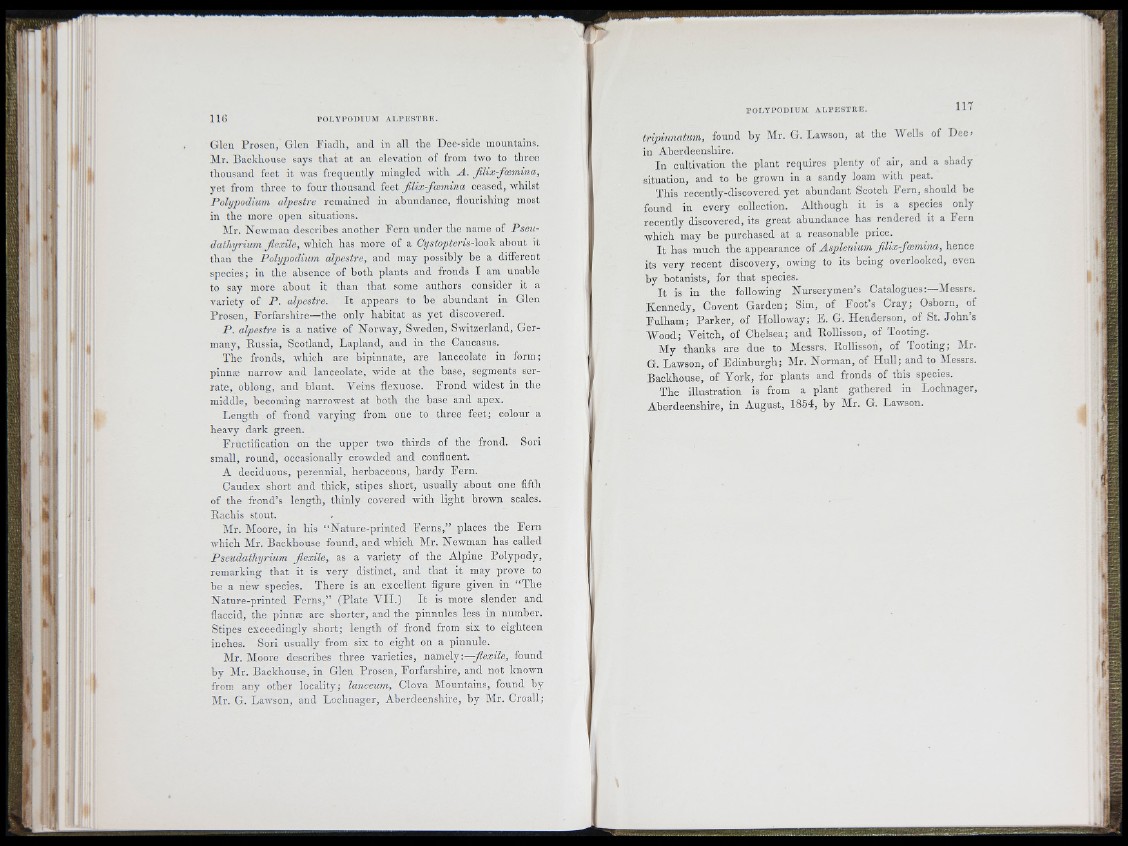
lU) V O L T FO i nUM Al . l 'HSTKU.
Glen Prosen, Glen P iad h , and in all tlie neo-side mountains,
Air. lîacldiousc says tliat at an elevation of from two to tliroo
thousand foot it was frequently mingled with A . filix -foe m in a ,
y e t from throe to lour thou.sand feet filix -foe m in a ceased, whilst
Polypodium alpestre remained in abundance, flourishing most
in the more open situations.
Air. Newman describes another F e rn u n d e r the name of Pseu-
datlujrium fle x ile , which has more of a Cystopteris-\ook about it
than the Polypodium alpestre, and may possibly be a different
species; in the absence of both plants and fronds I am unable
to say more about it than th a t some authors consider it a
variety of P . alpestre. I t appears to be abundant in Glen
Prosen, Forfa rsh ire—the only habitat as yet discovered.
P . alpestre is a native of Norway, Sweden, Switzerland, G e rmany,
Russia, Scotland, Lapland, and in the Caucasus.
The fronds, which are hipinnate, are lanceolate in form;
pinnæ narrow and lanceolate, wide at the base, segments serrate,
oblong, and b lunt. ATins flexuose. F ro n d widest in the
middle, becoming narrowest at both the base and apex.
L en g th of frond varying from one to three feet; colour a
heavy dark green.
Fructification on the u p p e r two thirds of the frond, Sori
small, round, occasionally crowded and confluent.
A deciduous, perennial, herbaceous, h a rd y Fern .
Caudex short and thick, stipes short, usually about one fifth
of the frond’s length, th in ly covered with lig h t brown scales.
Rachis stout.
Air. Aloore, in his “ N a tu re -p rin ted F e rn s ,” places the F e rn
which Air. Backhouse found, and which Air. Newman has called
Psexidatliyrium fle x ile , as a variety of the Alpine Polypody,
remarking th a t it is very distinct, and th a t it may prove to
be a new species. T h e re is an excellent figure given in “ The
N a tu re -p rin ted F e rn s ,” (Pla te V I I .) I t is more slender and
flaccid, the pinnæ are shorter, and the pinnules less in number.
Stipes exceedingly short; length of frond from six to eighteen
inches. Sori usually from six to eight on a pinnule.
Air. Aloore describes three varieties, riSxaAy.—fle x ile , found
h y Air. Backhouse, in Glen P rosen, Forfa rsh ire , and not known
from any other locality; lanceum, Clova Alountains, found by
Air. G. Lawson, and L ochnager, Aberdeenshire, h y Air. Croall;
tripinnatum, found by Air. G. Lawson, at the AVells of D e o
in Aberdeenshire.
In cultivation the plan t requires plenty of air, and a shady
situation, and to be grown in a sandy loam with peat.
This recently-discovered y e t abundant Scotch F e rn , should be
found in every collection. Although it is a species only
recently discovered, its great abundance has rendered it a F e rn
which may he purchased at a reasonable price.
I t has much the appearance of Aspdenium filix -foe m in a , hence
its very recent discovery, owing to its being overlooked, even
by botanists, for th a t species.
I t is in th e following N u rserymen’s Catalogues:—Alessrs.
K en n ed y , Covent G a rd en ; Sim, of Foot’s Cray; Osborn, of
F u lh am ; P a rk e r, of Holloway; E. G. H en derson, of St. Jo h n ’s
AVood; Veitch, of Chelsea; and Eollisson, of Tooting.^
Aly thanks are due to Alessrs. Rollisson, of Tooting; Air.
G. Lawson, of E d in b u rg h ; Air. Norman, of H u ll; and to Alessrs.
Backhouse, of Yo rk , for plants and fronds of this species.
T h e illustration is from a plan t gathered in Lochnager,
Aberdeenshire, in Aug u st, 1854, b y Air. G. Lawson.